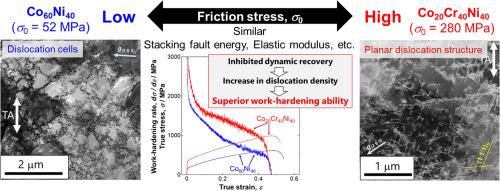面心立方高/中熵合金的特征变形微结构演化和变形机制
IF 9.3
1区 材料科学
Q1 MATERIALS SCIENCE, MULTIDISCIPLINARY
引用次数: 0
摘要
面心立方(FCC)高/中熵合金(HEAs/MEAs)是一种新型多主元素合金,在室温下表现出优异的机械性能,但其起源至今仍是个谜。在此,我们报告了拉伸变形 Co20Cr40Ni40 代表性 MEA 和 Co60Ni40 合金(一种传统的二元合金)的形变微观结构演变,以作比较。这些催化裂化合金分别具有高/低摩擦应力,在固溶体中具有基本的抗位错滑行能力,并具有相似的其他材料特性,包括堆积断层能。与 Co60Ni40 合金相比,Co20Cr40Ni40 MEA 具有更高的屈服强度和加工硬化能力。Co60Ni40 合金的变形微观结构特点是,无论晶粒取向如何,都存在粗大的位错单元(DC),在拉伸轴(TA)靠近<1 1 1>的晶粒中存在少量变形孪晶(DT)。相反,根据晶粒取向的不同,MEA 形成了三种截然不同的形变微观结构:在 TA 接近<1 0 0>的晶粒中形成细小的 DC,在其他取向的晶粒中形成平面位错结构 (PDS),在取向<1 1 1>的晶粒中形成高密度的 DT 和 PDS。三维电子断层扫描显示,MEA 中的 PDS 将位错限制在特定的 {1 1 1} 平面内,表明螺位错的交叉滑移和动态恢复受到抑制。拉伸变形过程中的原位 X 射线衍射显示,MEA 中的位错密度高于 Co60Ni40 合金。这些研究结果表明,具有高摩擦应力的催化裂化HEA/MEA会自然形成独特的变形微观结构,这有利于实现优于传统材料的机械性能。本文章由计算机程序翻译,如有差异,请以英文原文为准。


Characteristic deformation microstructure evolution and deformation mechanisms in face-centered cubic high/medium entropy alloys
Face-centered cubic (FCC) high/medium entropy alloys (HEAs/MEAs), novel multi-principal element alloys, are known to exhibit exceptional mechanical properties at room temperature; however, the origin is still elusive. Here, we report the deformation microstructure evolutions in a tensile-deformed Co20Cr40Ni40 representative MEA and Co60Ni40 alloy, a conventional binary alloy for comparison. These FCC alloys have high/low friction stresses, fundamental resistance to dislocation glide in solid solutions, respectively, and share similar other material properties, including stacking fault energy. The Co20Cr40Ni40 MEA exhibited higher yield strength and work-hardening ability than in the Co60Ni40 alloy. Deformation microstructures in the Co60Ni40 alloy were marked by the presence of coarse dislocation cells (DCs) regardless of grain orientation and a few deformation twins (DTs) in grains with the tensile axis (TA) near 〈1 1 1〉. In contrast, the MEA developed three distinct deformation microstructures depending on grain orientations: fine DCs in grains with the TA near 〈1 0 0〉, planar dislocation structure (PDS) in grains with other orientations, and a high density of DTs along with PDS in grains oriented 〈1 1 1〉. Three-dimensional electron tomography revealed that PDS in the MEA confined dislocations within specific {1 1 1} planes, indicating suppression of cross-slip of screw dislocations and dynamic recovery. In-situ X-ray diffraction during tensile deformation showed a higher dislocation density in the MEA than in the Co60Ni40 alloy. These findings demonstrate that FCC HEAs/MEAs with high friction stresses naturally develop unique deformation microstructures which is beneficial for realizing superior mechanical properties compared to conventional materials.
求助全文
通过发布文献求助,成功后即可免费获取论文全文。
去求助
来源期刊

Acta Materialia
工程技术-材料科学:综合
CiteScore
16.10
自引率
8.50%
发文量
801
审稿时长
53 days
期刊介绍:
Acta Materialia serves as a platform for publishing full-length, original papers and commissioned overviews that contribute to a profound understanding of the correlation between the processing, structure, and properties of inorganic materials. The journal seeks papers with high impact potential or those that significantly propel the field forward. The scope includes the atomic and molecular arrangements, chemical and electronic structures, and microstructure of materials, focusing on their mechanical or functional behavior across all length scales, including nanostructures.
 求助内容:
求助内容: 应助结果提醒方式:
应助结果提醒方式:


